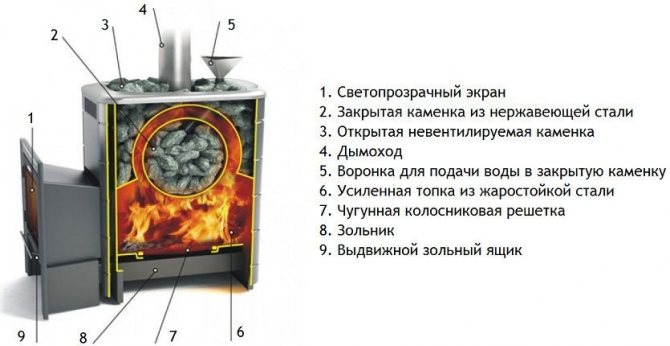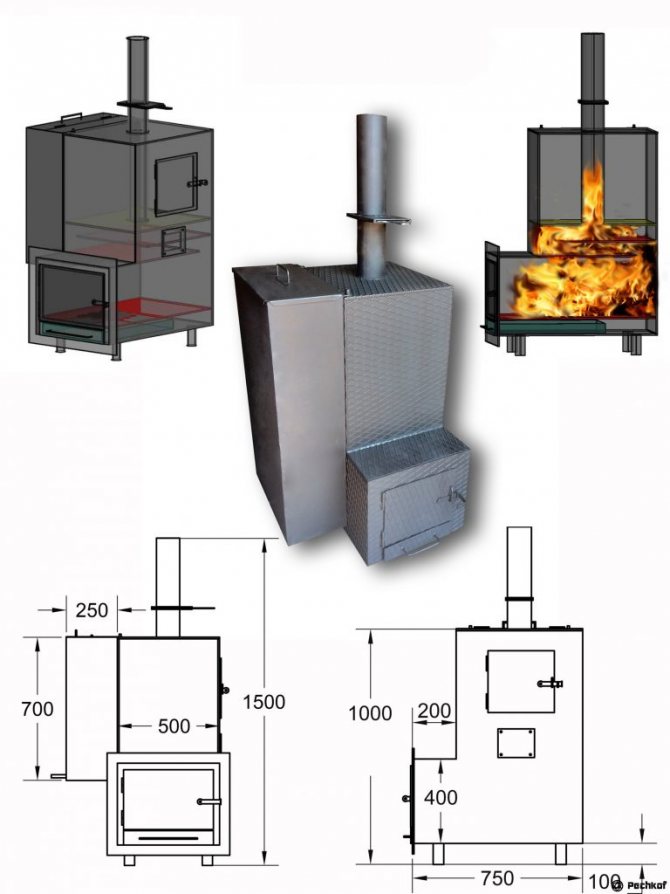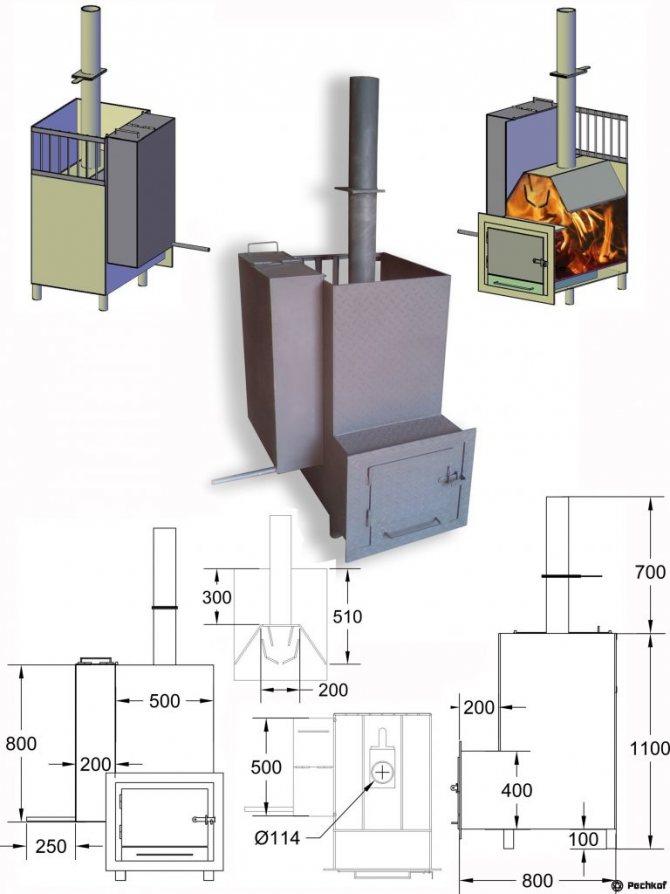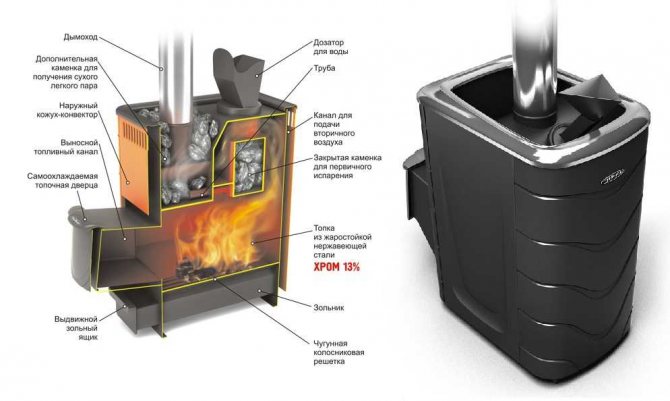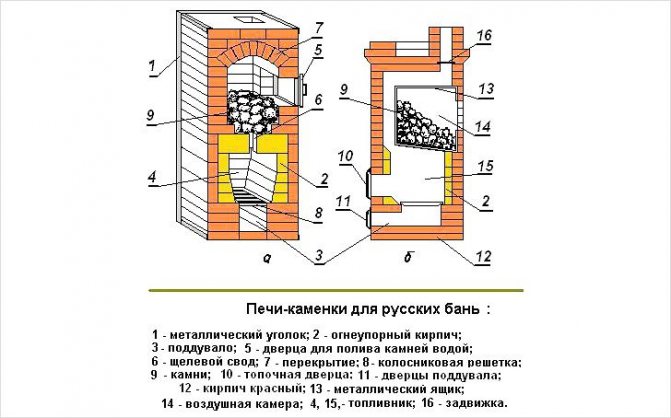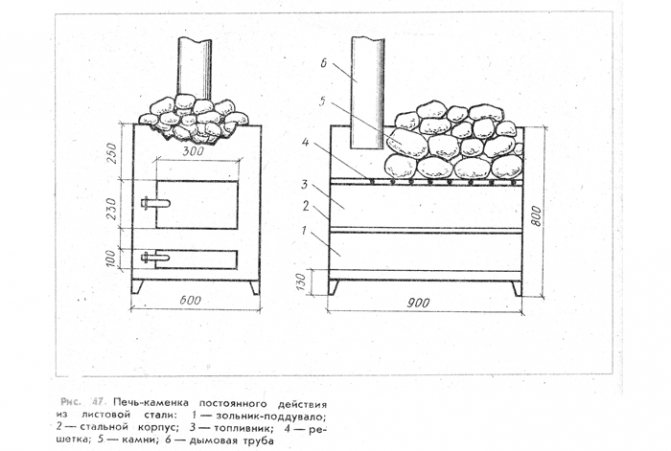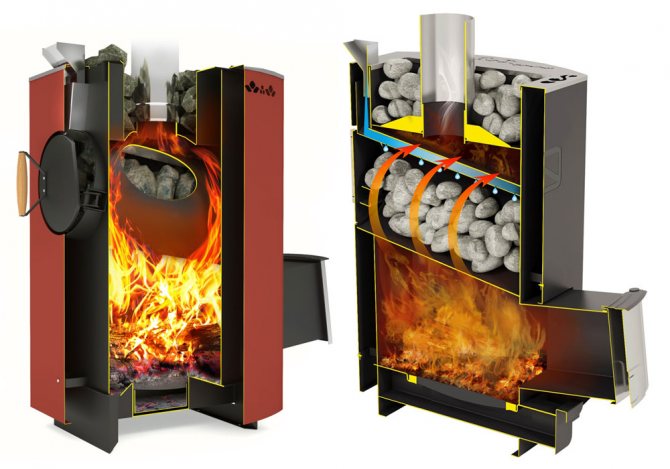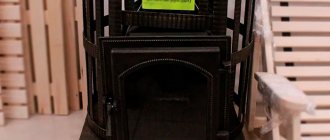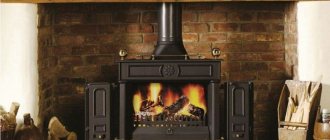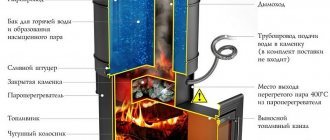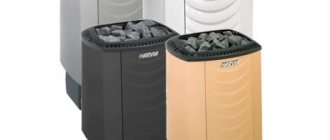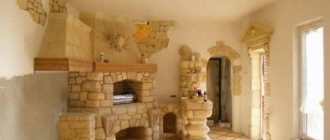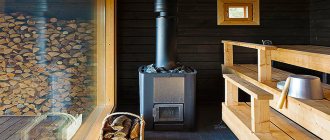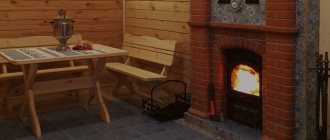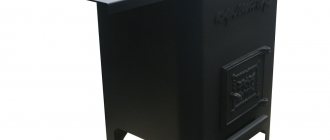Welding rules
Homemade metal oven
When welding, you must adhere to the following notes:
- It is not possible to maintain exact dimensions during grabbing and fitting. This is not scary, because when welding with a continuous seam, they will hide and will not be noticeable - run-up or deviations from different sides are compensated.
- To prevent the lid from falling into the box when brewing, a high round stand is placed inside it.
- The bottom of the inner heater is a 10 mm sheet. This will allow it to withstand the main heat of the flame, and too thin a bottom will quickly burn out. After that, smoke will begin to flow into the steam room.
Having completed the design of the top and bottom, proceed to the preparation of the holes. First, a small hole is made in the stove in the lower part - for the firebox.
- The box is laid horizontally and markings are applied in the right place.
- A grinder or a welding machine cuts a hole for the firebox.
- A door of the same size is cut from a sheet of metal blank.
- In the lower part (third) of the box in which the stones are placed, several holes are made for pipes - their number is selected as needed. They are placed at least 5 cm from the bottom baffle to improve traction. A box with heavy stones is supposed to be installed on them.
- Another hole is welded in the upper part - for inserting the inner case.
- Along the perimeter of the hole from 3 sides, two 4 cm wide plates are attached to the welding - to strengthen the cut line. The first 3 strips are attached to the inner surface of the case, and the remaining ones to the outer part of the window with mixing.
- A gap is left between the plates enough to insert the inner box.
- One plate is welded to the inside and to the doors of the firebox - for reinforcement.
- The firebox is fenced off from the ash pan with a grate made of steel rods with a diameter of 10-12 cm.
- For complete combustion of firewood, a better air flow is needed, so the grates are welded along the direction of the blower.
According to the assembly scheme, the furnace is made of 2 parts - internal and external - with a size difference of about 10 centimeters. This gap is necessary for the removal of combustion waste into the chimney. During assembly, the inner part is placed in an outer shell, which in the simplest case is attached to the smoke exhaust pipes. Their diameter is chosen as arbitrary, but not too small. Size should be sufficient to create good traction.
Principle of operation
Depends on the type of equipment selected. In gas models, fuel (most often propane) is mixed with air in the right proportions with controlled flow and releases heat during combustion. Thanks to this, the stone base quickly accumulates, and the water poured onto it turns into steam.
In electric heating elements, located in the inner case, stones are heated (with which they are lined). The latter, in turn, give energy to the air entering and exiting through special ventilation ducts. As a result, the room temperature gradually rises.
In wood-burning stoves, the fuel burns out and gives off the released heat to the stove or mesh casing. Due to this interaction, a particularly mild vaporization is observed.
All sauna stoves have two compartments in their design: a firebox (below) and a heater (above). Outside, the stove has either a metal casing (if the stove is not made of bricks) or stone lining.
For modern and simply the best sauna stoves, they are as follows:
- made of materials that can stably withstand heavy loads;
- overall safety of the device, reducing the likelihood of fire, poisoning and other risks;
- balance between the speed of heating, the speed of cooling and the provision of moisture;
- economy in terms of fuel consumption;
- easy-to-use dimensions.
And which one to choose?
Stoves for Russian baths have their own unique characteristics. A proper stove in a Russian bath should not harm your health. Metal stoves emit hard infrared radiation when they burn. Cast iron - too heavy. Cast iron grates are more durable. The choice of a stove for a Russian bath depends on the size of the room, tasks, and financial capabilities.
- From the point of view of the optimal combination of price and quality, for a small private bath we can recommend the "Harvia Classic 280 TOP". This brand has long been recognized as one of the most reliable. Harvia also has a democratic pricing policy.
- For gourmets - connoisseurs of truly Russian traditions, "Zhikharka" by V. Vasyukhin will suit. For business - his Cinderella. These models allow you to fully reproduce the atmosphere of a Russian steam room, please with their appearance. Thick metal provides durability. Metal ovens emit infrared radiation, but this does not happen here, the metal is used as a thermos, which allows the room to warm up slowly and evenly.
- "Kuban" has 2 small heaters - open and closed. This is her main advantage. There is a drawback - the small thickness of the walls. The number of stones is not enough to create the optimal steam for which the Russian bath is famous. But only an expert who uses all the advantages of a real Russian bath can feel this. The average man in the street is unlikely to notice the difference.
- The most budgetary decision will be "Laguna", which will cost about 16,000 rubles. An open heater for our purposes is not a very good solution. This made such models less popular. The optimum temperature of the stones is not less than +5000 C. When heated, they instantly turn the water on them into light steam, which is impossible for an open heater. The correct sauna stove should be with a closed stove. This will help to avoid many problems.
- Those who like to surprise their friends and boast can be offered "Hephaestus 3K". A forged cast iron firebox will become a central element in the interior.
There are three types of water tanks
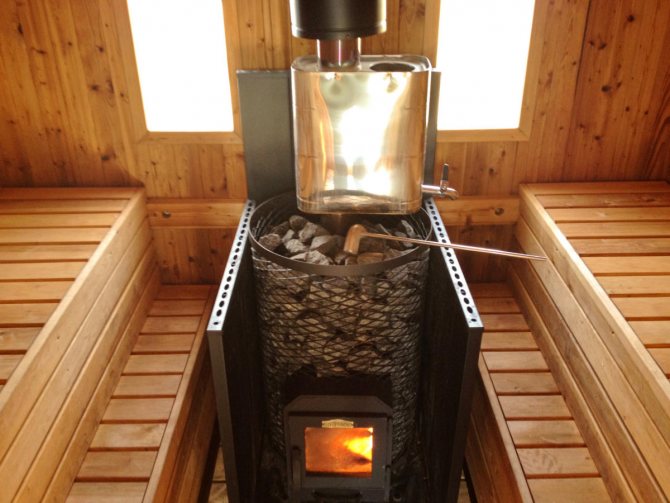
The tank is "samovar" type. This is a tank on the chimney pipe. The flue from the sauna stove passes through the water tank and the hot flue gases heat the water. Such a tank has a filler and drain hole. Usually, it is made of stainless steel.
Hinged tank. Such a tank is located close to or hangs on the furnace body. The water in it is heated by the heat from the walls of the furnace body itself.
Remote tank. This is a separately hanging tank, which can even be in another room. It is connected to a heat exchanger in the furnace and, due to this, the water is heated. But for such a tank, a special stove with a built-in heat exchanger is needed to heat the water. If you decide to choose a stove with a heat exchanger, it becomes possible to heat the steam room itself and adjacent rooms: dressing rooms, changing rooms, and other rooms.
From the course of metal science
All stainless steels are classified into three main groups: corrosion-resistant, heat-resistant and heat-resistant. Let's consider them in more detail:
- Corrosion resistant. For steel of this type, the simplest requirements are imposed on resistance to corrosion in normal living conditions and in simple operating conditions in industry. Handrails, staircases, household furniture and utensils, surgical instruments, rolled metal and sheet for the manufacture of metal structures not subject to the influence of an aggressive environment are made of them;
- Heat-resistant steels must be resistant to aggressive environments at high temperatures. They are mainly used as a structural base in the chemical and petrochemical industries;
- Heat-resistant steels - must maintain high mechanical strength at high temperatures. The latter quality can be very useful in the bath. Metal stoves are very common here, and burnout of the furnace body is a very common and extremely unpleasant phenomenon.
About ligature
The ligature is a set of additives, that is, elements additionally introduced into the composition of steel, which predetermine the receipt of certain specified properties and qualities from a commercial alloy. Among the main alloying materials for the production of stainless steels, it is worth noting:
- Chromium - imparts hardness and corrosion resistance in adverse operating conditions, due to the formation of a very strong and inert surface film consisting of oxides. The content of this material in the alloy, in an amount exceeding 17%, also determines high chemical resistance in aggressive environments.
- Nickel - gives plasticity, increases resistance to shock loads. It also makes a significant, and sometimes a decisive role in the formation of corrosion resistance. According to the subjective opinion prevailing among ordinary consumers, the higher the nickel content in the steel composition, the higher its mirror properties. That is why, in saunas, high-nickel food polished stainless steel is used as reflectors for decorating the baking space.
- Tungsten, due to the formation of high-strength compounds - carbides, increases the mechanical strength, abrasion resistance, heat resistance of steel.
- Cobalt makes a large contribution to the increase in heat resistance. However, the increase in mechanical strength also directly depends on the presence of this substance in the ligature.
- Silicon - increases the strength, elasticity and, which is very important for sauna stoves, the scale of the steel alloy. In this case, its content in steel ranges from 0.95 to 1.55%.
- Similar to the action of silicon and the properties of manganese. It also increases the elasticity of the steel without compromising the quality of the molecular bond expressed in the overall mechanical strength of the steel product. Agree that this quality is very important for a product such as a sauna stove, which is subject to frequent temperature changes and, as a result, high linear loads.
- Titanium increases the mechanical strength and overall corrosion resistance of steel. At the same time, being a metal with a low specific density, it does not increase the weight of the finished product.
- Copper - being a non-ferrous metal, makes a significant contribution to the corrosion resistance of even simple, low alloy structural steels. Thus, the content of copper in the alloy at the level of 0.4% increases its overall corrosion resistance by 17%, and under certain conditions, up to 22%.
Operating tips
Even the best oven can malfunction if installed incorrectly.
It is very important to place the heater in an environment of non-combustible materials. Before the firebox of the fire stove, a steel sheet with a minimum size of 1x1 m should be filled
For recommended fire clearances, refer to specific regulations. The distance to shelves, partitions made of wood must be kept at least 1.1 m.
Before starting the stove, it is necessary to check the draft in the chimney every time. Grates, ashtrays and grates should be thoroughly cleaned. If there is no draft, it is required to carefully clean the chimney. Skilled bath attendants find that it is best to heat the stoves with hardwood. Apple, pear and cherry are slightly worse, but more expensive.
It is undesirable to use pine wood. In last place are conifers. They give a little heat and a lot of burning, soot. It is strictly forbidden to heat the sauna stove:
- rotten board;
- old boards;
- painted wood, plywood, impregnated with various wood compounds;
- old clothes;
- plastic.
It must be remembered that freshly cut wood has a moisture content of 40%. It should lie down for up to several weeks, which allows the humidity to be reduced by up to 20%. At the very bottom, paper or tree bark is laid (best of all, birch bark). It is undesirable to use any kind of ignition mixture, including for tourist use. In the most difficult cases, dry alcohol tablets should be used.
It is not necessary to overfill the firebox with firewood. The maximum filling is 2/3 of the volume. As soon as the firewood burns out and the coals decay, it is necessary to cover the firebox itself, the view and the blower. Putting firewood in an iron stove should be done often, but in small portions. For a cast-iron, especially a brick hearth, this is no longer so important.
Smoke is often triggered by stacking firewood too tightly. Premature shut-off of the blower also disrupts the circulation of gases. Strong fire with powerful thrust is not always optimal. Competent bath attendants generally try to burn a small amount of firewood slowly. At the same time, they still achieve excellent warm-up.
fd2d612e384629fa06d7f9f58324af72.jpe
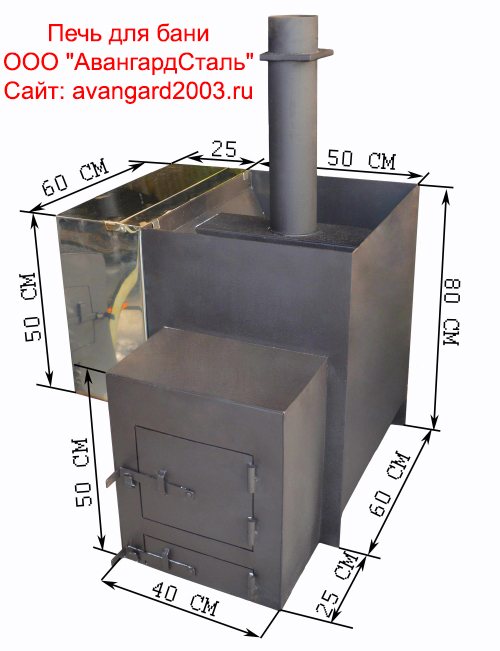

f902fa262958931bce6ad7197ef00c2c.jpe
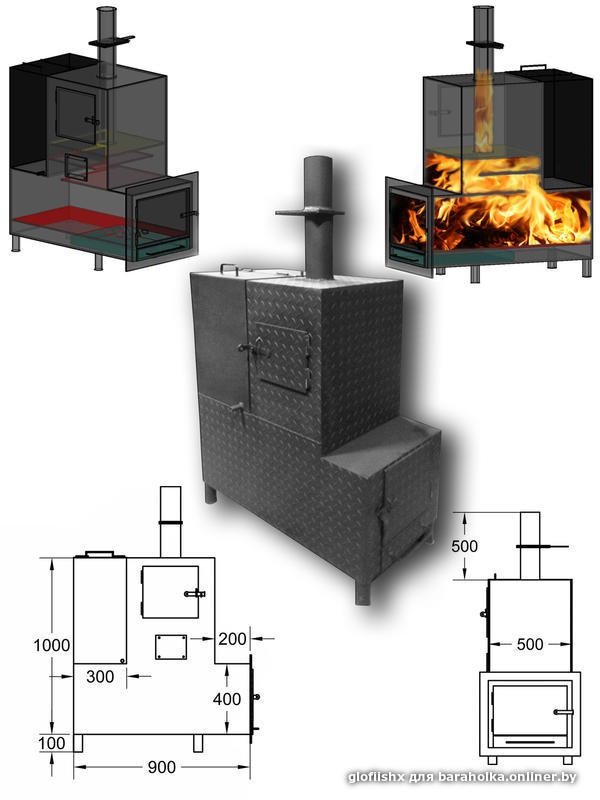

Adherents of electric stoves, of course, such recommendations are unlikely to work. The specific connection diagram is selected individually each time, taking into account the design features and the specific building. It is recommended that you consult a professional electrician whenever possible.
Before starting the installation, you should immediately check the completeness and appearance of the oven. In case of any deviations from the norm, you must immediately stop working and turn to professionals for help. Wherever wiring is laid, walls and other surfaces should be reinforced. Of course, only one metal wiring is used, without twists. No more than one electrical network is placed on one steam room, only wires with a cross-sectional margin are used.
Any sauna stoves and stoves installed in saunas should be mounted as evenly as possible. Deviation from the intended plane is very dangerous
It is imperative to install the junction boxes outside the steam rooms. If this is not possible, it is better to spend a hefty amount on the services of a professional electrician than to face problems later.
It is required to use in any case heat-resistant (rated for at least 125 degrees) junction boxes.
The normal operation of electric ovens is guaranteed only with the correct organization of air exchange. Complete replacement of indoor air should take place at least hourly. The owners of the sauna will only benefit if it is produced in 40-50 minutes. It is advisable to organize air supply directly from the street. If this cannot be done, let the nearest dry room be the source.
An extinguished wick means that you must immediately interrupt the ignition and ventilate the room itself, the chimney. Violation of this rule could result in a serious explosion!
About which stove to give preference, see below.
How to choose the right gas stove for a bath
The stove is the most important element of the steam room. It depends on her how comfortable and useful a visit to the bath will be, and how much it will cost.
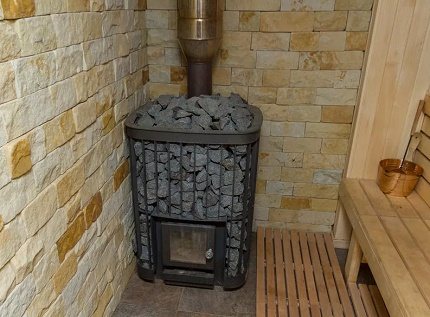

Gas stove design is not the last selection criterion. The volume of stones is also important, splashing water on which you can adjust the hardness of the steam and other characteristics of vaping
As for the technical parameters, the main ones are:
- the area of the paired room;
- rated power;
- type of firebox;
- material of manufacture;
- control method;
- installation features;
- design.
If the power of the stove is too large for the volume of the steam room, then the air will heat up quickly, and the stones will not have time to warm up. This means that getting decent steam will be problematic.
At low power, the furnace will work at the limit of its capabilities, which will lead to its rapid wear and deformation.As a result, you will have to spend money on expensive repairs or even buy a new unit.
Therefore, it is necessary to determine the volume of the steam room, add to it the volume of adjacent rooms, if they are also planned to be heated using the same oven. You can add 20-25% to the resulting value and, based on this data, choose a model according to the rest of the criteria.


Facing a gas stove with bricks or natural stone slabs significantly increase the heat transfer of the unit, protect bath lovers from direct exposure to high and ultra-high temperatures
It is important to pay attention to the firebox, which must be made of steel grades that can withstand high temperatures and their significant drops. It is desirable that the stove has thermal inertia, that is, it can retain heat after being turned off. This will not only save fuel while swimming, but also dry the bath rooms after completing all procedures.
This will not only save fuel while swimming, but also dry the bath rooms after completing all procedures.
It is desirable that the stove has thermal inertia, that is, it can retain heat after being turned off. This will not only save fuel while swimming, but also dry the bath rooms after all procedures are completed.
If the stove will heat water for the shower room, which is located outside the steam room, it is worth choosing a model with a remote tank. Lovers of wet steam need to buy a stove with an open heater. For connoisseurs of dry heat, you will need a unit with a closed heater, in which the stones reach 500 ° C.
Multi-mode models will help you not to limit yourself to one thing and, depending on your mood, take a steam bath in a Russian steam room, or in a Finnish sauna. Some stoves are capable of providing the conditions of an oriental hammam and infrared sauna.
Additional equipment will allow you to control the unit from a distance and prepare the bath for your arrival, being hundreds of kilometers away. It remains to wish you a successful purchase and a light steam!
How to determine the power of a gas bath stove
If it is decided to purchase a gas stove for a bath, you need to focus on several basic selection criteria. And the main, of course, will be the required thermal power.
According to its characteristics, the stove must be able to cope with its direct task - to create and maintain the required temperature in the steam room. That is, we are talking about the thermal power of the purchased unit.
It is usually assumed that one cubic meter of steam room volume requires about one kilowatt of furnace power, regardless of the type of fuel used. It would seem that everything is simple: multiply the linear dimensions of the room by height, length and width - and the desired value is "in your pocket." However, this issue has its own nuances.
This approach justifies itself only if the steam room has a full-fledged, made according to all the rules and on the basis of thermal engineering calculations, thermal insulation, including with the recommended reflective vapor-proof material such as penofol. Then the natural wood lining does not require additional heat.
But in practice, there are sections in the steam room, and sometimes very significant ones, which become "gaps" in the thermal insulation. They must also be taken into account by making the appropriate amendments.
If there is a window in the steam room, then in any case it contributes to the loss of heat. In this case, it is necessary to add 3 kW (or 3 m³ to the volume of the room, as it is convenient for someone) for each m² of the window, if it has one glass, and 1.5 kW, if the window is with double glazing or double-glazed windows.
Brick (stone) sections of the walls, or surfaces tiled with ceramic tiles, have a high heat capacity, and an additional 1.2 kW is added for each m2 of such a section.
Log walls (or walls made of timber) have a very high heat capacity, but in order to create and maintain the desired microclimate in the bath, they must be warmed up. If the bathhouse in the log house does not have an internal thermal insulation lining, then the conditional volume of the steam room (that is, the power of the furnace) should be increased by one and a half times.
An uninsulated door (a thin wooden board or even a newfangled glass door) will require an additional 1.5 kW.
When the fuel window is located in an adjacent room, heat losses through this "bridge" are inevitable as well. Therefore, it is necessary to make an amendment for this circumstance, on the order of an additional 10 percent.
In total, a very significant increase in volume can be accumulated. And, when choosing a stove, it is recommended to consider such models so that the calculated total value is approximately in the middle of the power range (or steam room volume) indicated in their passport.
And one more nuance: the furnace model can be one, but it can be equipped with burners of different power - this is also worth paying attention to.
Views
How to choose a stove for a bath to ensure quick heating of the premises and a comfortable rest at any time of the year? High-quality equipment should be compact, durable, convenient and safe to use.
Meanwhile, it is better to choose models of stoves for a Russian bath, which have sufficient thermal power and the ability to form thick and saturated steam.
There are three types of sauna stoves on the modern market:
- Wood-burning;
- Electrical;
- Gas.
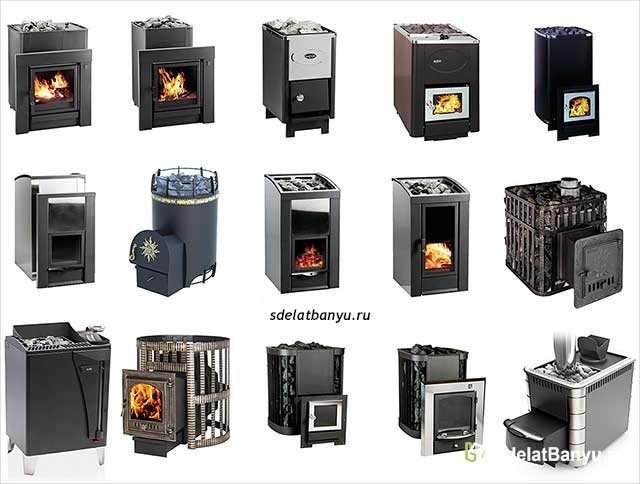

Wood burning
Wood-burning stoves can create a special atmosphere of coziness and comfort in baths and saunas. Such furnaces are practical, convenient and durable.
Wellness procedures can be started 40 minutes after the start of the heating process. Among other things, a wood-fired sauna stove promotes efficient heat accumulation over a long period of operation.
To choose a wood-burning stove, it is important to know some of its distinctive characteristics:
- The firebox in such a stove can be of a remote or built-in type of different volume;
- In some models, the doors are made of fireproof glass, additionally equipped with an expansion water tank and grate.
- Brick or metal is used for the manufacture of the case.
Brick
The brick stove has a complex design and impressive dimensions.
Such an oven is intended exclusively for installation in a bath, since it is not capable of providing high air convection at high temperatures and low humidity.
The construction of a brick heater provides for the arrangement of a separate foundation base using refractory bricks and a connecting clay mortar. To carry out the brickwork of the walls, a special brick is also used that can withstand significant temperature changes.
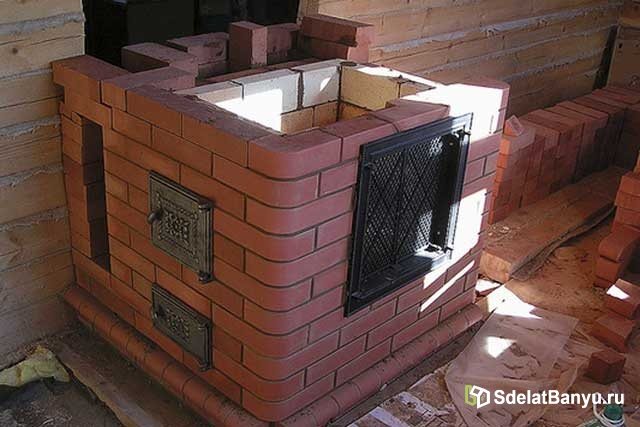

Metal
The wood-burning metal stove is quite popular and in demand due to its compactness and practicality. This is the best option for small-sized steam rooms - it does not require much space, has a high heat transfer, and has an attractive appearance.
Heat-resistant steel or cast iron is used for the all-welded construction of the stove, which allows installation of the equipment in any suitable place.
Metal stoves are sufficiently sealed, therefore, they exclude the ingress of smoke and gas into the room.
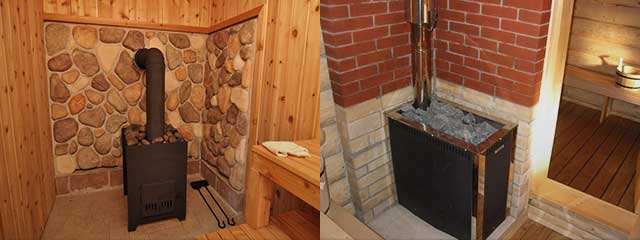

Electric
The simplest and most affordable option for heating any bath is electric ovens, which are characterized by high power, compact size and high air heating rate. Electric heating equipment is installed without a chimney, therefore completely eliminates the possibility of carbon monoxide poisoning.
The electric heater is convenient and practical to use, equipped with an automatic control system.Lightweight metal body eliminates injury and burns.
The main disadvantage of such equipment is high power consumption.


Gas
Gas ovens are less in demand compared to electric counterparts. They provide fast heating of water and maintenance of optimum air temperature in the steam room. Such units are rather bulky and heavy, therefore they are suitable only for large steam rooms.
2beac8c3e15f60303e4aaa81ed29c4a5.jpe
The main disadvantage of gas stoves is the high gas consumption, and if the bath is not connected to the central gas main, then the purchase and replacement of gas cylinders will require large financial costs.
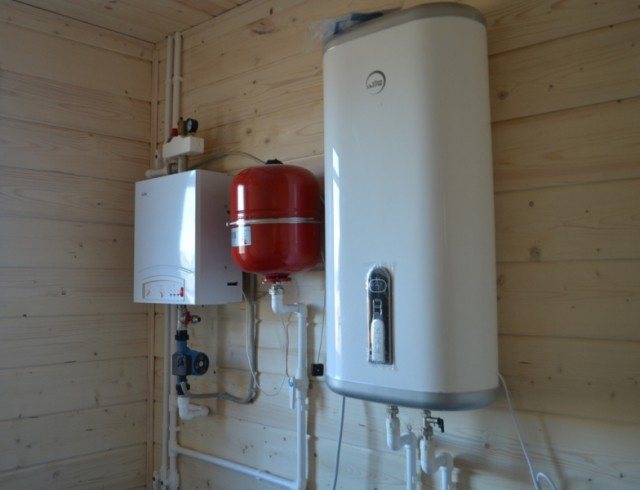

Gas oven design
In terms of their design features, gas-fired stoves are similar to classic wood-burning ones. The only difference is that the former have a panel with a gas burner instead of a door for loading firewood.
Some models are universal, they can be additionally equipped with a firebox for firewood and a unit with a gas burner and a remote control system. This design can operate both on wood and natural gas.
With such a device, you can heat water, receive steam, heat the steam room and adjacent rooms with a volume of 6 to 24 m³.
A gas stove for a bath consists of the following elements:
- powerful burner with volatile automatic control and safety;
- firebox: a unique heat exchange system which allows you to evenly distribute heat;
- smoke exhaust system, in which the length of passage of the flame and combustion products is increased;
- heat exchanger: located on the left or right side of the firebox;
- a container for an open heater, in which there is a ventilated mode of operation;
- casing-convector: responsible for creating a flow of hot air, and also performs the function of protecting against infrared radiation;
- ash pan: due to this element, air enters the firebox, and through it, preventive work is carried out to clean the combustion products that crumble through the grate (if firewood is used as fuel).
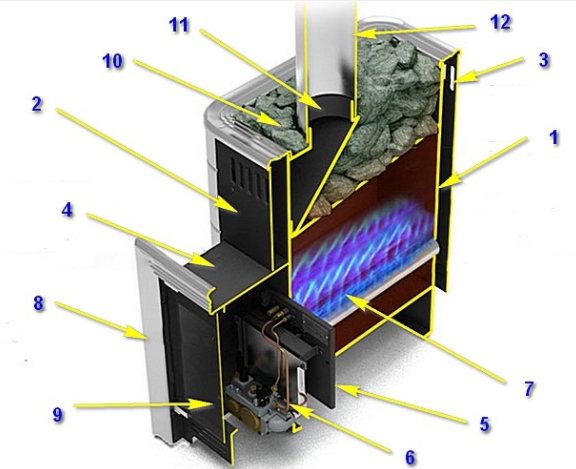

The device of a gas stove for a bath Termofor Urengoy
Using an example, we will consider in detail the device of a gas oven Termofor Urengoy.
The main element in which the heat generation process is carried out is the combustion chamber (1). Usually its walls are made of high-strength steel, the thickness of which is from 0.8 mm. Thanks to these characteristics, the gas sauna stove will function safely for a long period of time.
The outer casing (2) is also made of steel, but here the metal is 3 mm thick and is separated from the casing by means of an air gap.
Since the air is open from below, and there are special windows (3) on the top along the perimeter, such a design is a very powerful convector that provides quick heating of the room allocated for the steam room.
From the side that is directed to the dressing room, the stove very often has an elongated fuel channel (4), thanks to which it is possible to take out the loading window, and directly the gas equipment from the steam room through the wall.
Inside the fuel channel there is a panel (5) that overlaps it and acts as a base for attaching the gas block (6) from the outside and gas burners (7) from the inside.
The burners can be installed differently in different oven models. In this case, the Sakhalin kit with two burners is used.


Gas oven burner
Burners are classified according to their heat output.
For a more attractive appearance of the equipment, the fuel channel window has a frame made of a decorative metal casing and a heat-resistant screen (9).
The design of any sauna stove includes a heater.The compartment for stones can be located on top (10) or along the front and side walls, and sometimes it can even cover the entire furnace body.


The device of a gas stove for a bath with two heaters
Some models have two heaters (open and closed).
The picture on the right shows a model with two heaters (13). The inner compartment is in contact with the flame of the burners, therefore a shield (14) is provided for additional protection.
Like any other stove, the gas sauna heater is equipped with a pipe for connecting a chimney of a certain diameter (11). And the initial, single-wall section of the pipe is very often used to install a tank for heating water.
Various materials can be used for finishing the furnace body. The most commonly used metal surface is coated with a heat-resistant paint, usually black.
Models of wood-burning stoves for baths and saunas are available from the manufacturers Hephaestus, Feringer.
DIY making
Before making a stove with your own hands, it is necessary to take into account that the design should be economical and generate only healthy heat. It is by these criteria that wood-burning models are not inferior to electric and gas
However, to make such a metal structure yourself, you need a little welding skill.
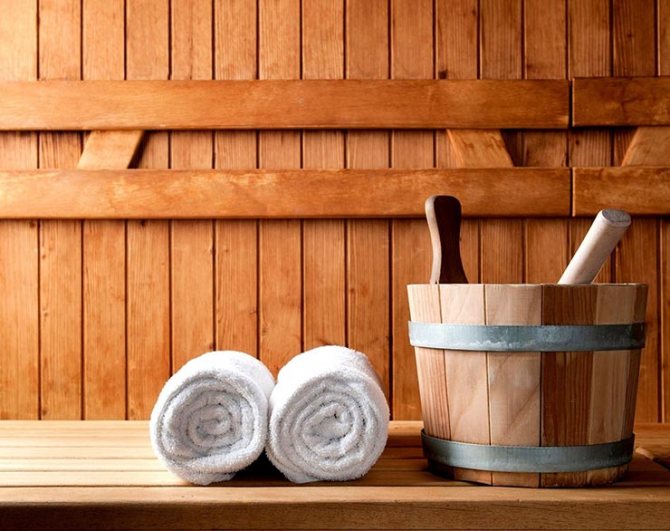

Even an inexperienced builder can build a sauna stove with his own hands.
A structure that is made of metal must meet certain requirements:
- Heat up and increase the temperature in the steam room in a short period of time. As a rule, iron furnaces are the best ones to cope with this task.
- Keep warm for a long time. Since the metal has the ability to quickly heat up and cool, it will require a heater that accumulates heat, or it will take more time for the furnace to burn. Another method of long-term preservation of heat is to cover the sauna stove with a brick after its installation.
- Take up a small area in the steam room. If the room is too small, then it is best to make vertical models with a loading door, which is carried out into the dressing room.
- Be absolutely safe for people in the bath. To protect yourself from burns, a convection casing made of thin sheets of iron is installed on the building's body. But you can also build a brick wall near the structure.
The easiest way will be to make a wood-burning stove in a bath from a steel pipe, the diameter of which is from 300 to 500 mm. You can also use a gas cylinder for these purposes. There may be several reasons for this:
- The pipe is already a completely finished structure body, which simplifies the entire production.
- The cylindrical shape of the material is considered more suitable for making a furnace than rectangular, since considerations of aerodynamics and heat transfer are taken into account here.
- Vaulted surfaces without seams have a longer service life than flat ones.
- The round design is more convenient for cleaning soot and ash.
Each oven has a number of its own characteristics. The most popular are 3 types of metal structures:
- An ordinary horizontal stove made of a gas cylinder, which is heated from the inside of the steam room.
- A stove made of a 53 cm pipe with a remote firebox.
- Three-in-one boiler, which is located in an upright position.
The first types of stoves are the easiest to manufacture, have small dimensions, and are mobile. To make such a structure, you will need an unnecessary gas cylinder, the diameter of which is 30 or 50 cm. You will also need metal scrap.
First you need to properly cut the top of the cylinder right along the production seam. To do this, unscrew the gas valve with an open-end wrench, fill everything inside with water, and then proceed to pruning with the help of a grinder. Then you should proceed in order:
- Cut openings on the back of the cover for installing the doors and flue pipe. Build an ash or loading door frame from metal strips, and then attach them by welding to the openings.
- Using a welding machine, build a grate, place the corners that must be fixed from the inside of the cylinder. Attach the split top back into place.
- Make the shutters, put them on the hinges, attach the locks.
- Attach the legs and the pipe through which the smoke will come out to the main structure.
At the end of the assembly, all the old paint remaining on the cylinder must be removed from the finished sauna stove. It is best to do it outside. Then the product is disinfected and painted again using a heat-resistant composition of the KO series.
To make a unit with a remote firebox, it is necessary to prepare metal parts and cut the pipe to the desired size. During the preparation of the metal for the additional section of the furnace, it is necessary to measure the thickness of the walls between the steam room and the dressing room. So you can calculate the width of the build-up of the part that will go into the opening of the partition. Then everything is done in a specific sequence:
- It is necessary to make a hole in the upper part of the pipe, weld the chimney pipe to it, and attach legs to the bottom of the firebox. Install the grate.
- Make the front section, and then weld the firebox using electric welding. Attach a blank metal disk to the boiler end of the body.
- Make doors insulated with basalt wool. Weld the handles to them and install the finished doors in place.
The best metal stove for a bath
Thermofor Geyser is a classic design and functionality. Made of heat-resistant black alloy steel, it is a reliable material. Wall-mounted, belongs to the closed type. Combined fuel. The furnace is designed to generate steam and heat water.
Standard features include ash drawer, flame level control. The walls of the firebox are 0.3 cm thick. The stove is divided into two parts - open and closed.
In the first, steam is formed, in the second it is dried. Dosing valve built into the funnel to prevent large amounts of water from entering.
Specifications:
- Heating volume - 18 m3.
- The volume of the firebox is 40 liters.
- The length of the firewood is 50 cm.
- Dimensions - 41.5 × 90 × 83 cm.
- All - 59 kg.
Pros:
- Simple to use. It is connected to the chimney at the top, there is protection against water ingress inside.
- Reliable case. Made of heat-resistant steel.
- Laconic style. Will fit into the bath of any idea.
- Light weight. You can calmly move when arranging the territory.
Minuses:
- Noise. Rumble with active firewood burning.
- Working area. For a small bath.
The best stainless steel sauna stoves
Thermofor Tunguska
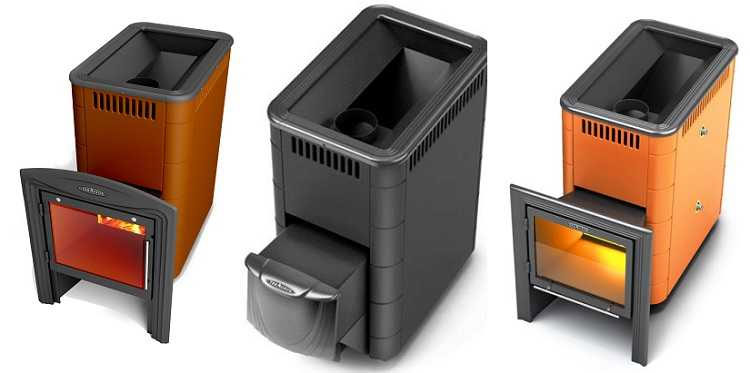

An excellent specimen, which is also not very expensive. This oven very quickly heats up a steam room with a volume of up to 18 m3. The heater available here warms up from all sides - this is the key to efficiency.
Advantages:
- Suitable for a Russian bath of any configuration;
- Gives out finely dispersed steam;
- Very fast heating;
- The volume of the firebox and heater will suit everyone;
- Adequate cost;
- Very easy installation.
Disadvantages:
- Design is not for everybody;
- It cools down very quickly.
The main advantage of this model is its very fast heating. The trouble is that it cools down very quickly. Reviews on Termofor Tunguska indicate that you need to remember to throw firewood into the firebox, otherwise it can quickly cool down.
However, its 60-liter volume allows you to do this not too often. The room is heated by this oven due to the convector casing, which creates a powerful stream of hot air.
Thermofor Geyser 2014


Another worthy stove designed for a Russian bath. For its production, heat-resistant alloy steel was used. Steam generation is two-stage here.This means that heavy steam is generated by the oven, which is dried in the second compartment, after which it goes into the steam room.
Advantages:
- Light and pleasant steam;
- Nice appearance;
- The stove holds 70 kg of stones;
- Combined fuel;
- Optimal price tag;
- Extremely fast heating;
- The case turned out to be very reliable.
Disadvantages:
With intensive firewood burning, a hum is heard in the chimney.
Much more important is the fact that the stove is capable of boasting a long service life - it is possible that it will outlive the bath itself. It is capable of heating a room with a volume of up to 18 m3 - this is quite enough for most owners.
Harvia Legend 240 Duo
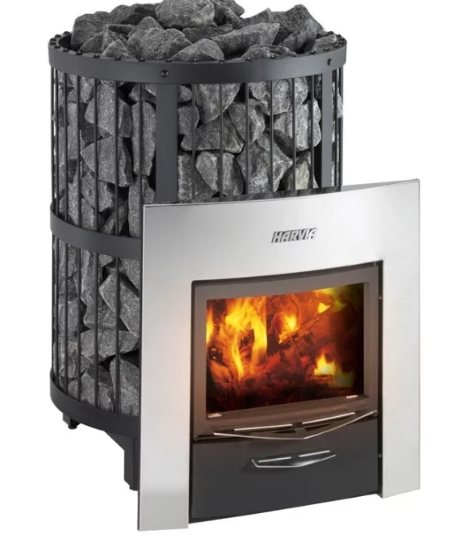

The Finnish manufacturer has worked in this field for 60 years and now shows a very decent result. Harvia Legend 240 Duo is distinguished not only by its attractive appearance, but also by its high-quality device. The large stone compartment holds up to 200 kilograms. This stove is suitable not only for a Russian bath, but also for use in a sauna, because it can produce a high temperature, while leaving the humidity at a low level.
Very often, the premises allocated for the steam room are small in area. However, the innovations that were used in the design of the stove allow you not to worry about fire safety when installing it. Items in the steam room can be located depending on the wishes of the developer. The large volume of the stove is also an advantage in comparison with analogues. Firstly, it allows you to get a large amount of quality steam. Secondly, you can lower the temperature without losing the amount of steam. This can help people who are not allowed to take a bath because of the high temperature.
pros
- Large stone compartment.
- Rapid heating of the room.
- A lot of steam.
- High quality material.
Minuses
It is possible to add a tank, but it must be purchased separately.
Vladislav, 56 years old.
I got the stove half a year ago. Very happy with the purchase. When I just installed it, I was surprised that there was a lot of free space in the steam room. Of course, I saw that the stove was compact, but I did not think that it was so compact. However, steam quality and heating time are not affected. About 30-40 minutes is enough for the steam room to warm up to 80 degrees. The steam is light and pleasant. And the design is nice too.
The device and principle of operation of a gas bath stove
A gas sauna stove is structurally reminiscent of a simple boiler. The main difference is the principle of space heating. The working process is based on natural or forced convection of air currents in the twin room.
The internal structure of the gas furnace
According to the standard, gas stoves for a bath have the following elements in their design:
- a gas burner is mounted in the body;
- then carry out a hermetic connection of the gas pipeline with the burner;
- additionally, you can fix the water tank;
- a pallet with stones is installed on top of the body and a pipe is brought out to remove the products of gas combustion.
If we consider that cold water will be poured into the gas heater for a bath to create water vapor, then you need to choose the ideal stones that can withstand such a sharp change in environmental conditions. Large sea or river stones are the best that can be used to create steam in a steam room.
It has been proven in practice that they perfectly withstand extreme thermal stress and temperature extremes. They heat up very quickly, and the maximum heating temperature reaches 200 degrees Celsius.
Additionally, a thermostat and a fuse are built into each gas bath stove, which blocks the gas supply when the fire is extinguished. The gas chamber, where fuel is burned, is placed clearly under the stove, which allows the stones to be heated to the maximum temperature in the shortest possible time.
Installation rules for gas ovens
The process of installing gas-fired heating devices must be approached as responsibly as possible.Not only the efficiency of functioning depends on the correct installation, but also the safety of people visiting the bathhouse.
Experienced specialists with extensive experience in this area should work with gas ovens. Having entrusted the installation of a gas boiler to a professional, the installation process should still be monitored. When carrying out such work, you need to pay attention to the following things:
- the distance from the wall to the stove must be at least 50 mm. In this case, all surfaces parallel to the walls of the boiler are made of non-combustible materials or sheathed with such;
- the refractory base of the boiler must protrude at least 100 mm from its edges;
- the height of the connector for the burner without a cover should vary from 470 to 550 mm, with a cover - from 615 to 680 mm, width - from 350 to 450 mm and from 515 to 665 mm, respectively.
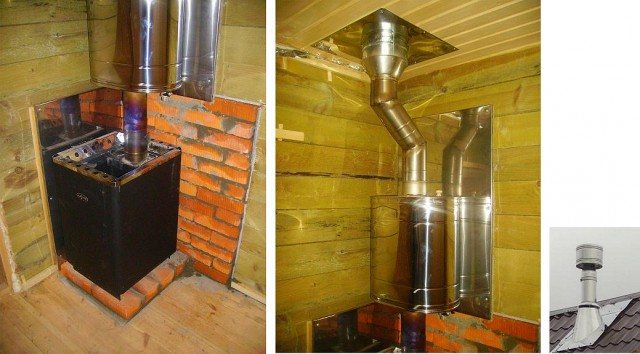

Particular attention should be paid to the chimney. The gas oven is connected to the chimney with stainless steel pipes. In this case, the pipe elbows must enter each other by at least half a diameter.
The gas boiler is installed simultaneously in the steam room and the dressing room. The front side with burners should be located in the dressing room. This eliminates the possibility of fire extinguishing due to water ingress. A boiler with water and a heater are placed in the steam room.
A prerequisite for the operation of a gas oven is the presence of a hood and windows with vents in the dressing room. Doors should open outward. The length of the chimney must be at least 5 meters.
If the chimney is made of different materials, for example, stainless steel pipes are attached to the stove, and then the channel is made of brick, then the junction must be completely sealed. This location in the heating system should be checked as often as possible.
Criterias of choice
The most important moment, allowing you to choose the right stove for a home mini-sauna, and for any other sauna, is the power of the device. After assessing the required indicator, you need to choose devices that cover this level with a margin. If the stove is used with insufficient power, the life of the appliance will be shortened. But also a large reserve of heat is not needed, because this means excessive consumption of energy or fuel. Usually a stock of 2-3 kW is enough.
The required power is calculated taking into account:
- door material (glass entrance - adds 1.5 m3 to the estimated volume);
- surfaces without thermal protection, for which a coefficient of 1.2 is introduced (with subsequent addition to the volume);
- the probable absence of thermal insulation (in "bare" log cabins, a factor of 2 is used);
- the need to heat adjoining rooms or warming them up with another heat source;
- the need for heating the sauna in winter (or no such need).
As already mentioned, brick and cast iron structures have a long period of operation. For a long time, hearths made of steel with the addition of 17% chromium can work. However, the cost of such products is sometimes too high. Do not use a gas burner in a wood-burning stove.
In any case, if there are no special wishes, it is necessary to give preference to stoves made of solid cast iron. Traditionally, such devices are shielded with a brick layer. However, it is useful to be able to remove individual bricks and thereby speed up the warm-up. The design should be chosen according to personal preference only. The size of the sauna stove should be selected according to the size of the room and the ease of use.
Criteria for selecting a heat-resistant steel furnace
Stainless steel stoves for a bath are quite expensive things, so their choice should be deliberate, and long-term operation.
How can this be achieved? Compliance with the following defining key rules:
- According to technical conditions, heat-resistant steel must contain at least 12.85% chromium and not more than 0.18% carbon.
- The determining factor in the quality of heat-resistant steel is the temperature of the onset of scale formation.For quality raw materials, this temperature ranges from 760 to 910 degrees Celsius.
- In the process of scale formation, the oxidation of the contact surface of the metal occurs, with the participation of oxygen atoms, which gives reason to some experts to assert that the use of heat-resistant steels makes the atmosphere in the steam room more favorable in terms of the volumetric oxygen content. The statement is very controversial, since, with normally operating ventilation, the lack of oxygen must constantly be replenished by the flow of fresh air.
- There is no way to accurately determine heat-resistant steel by visual or other organoleptic characteristics. The answer can only be given by a technical certificate or instrumental express analysis of raw materials.
A word from the Experienced! The "legendary" method of determining the quality of stainless steel "on a magnet" so popular among scrap metal hucksters cannot give a key answer about the quality of the alloy and the chemical composition of the alloy. It should be said that most high-chromium steels react positively to a magnet.
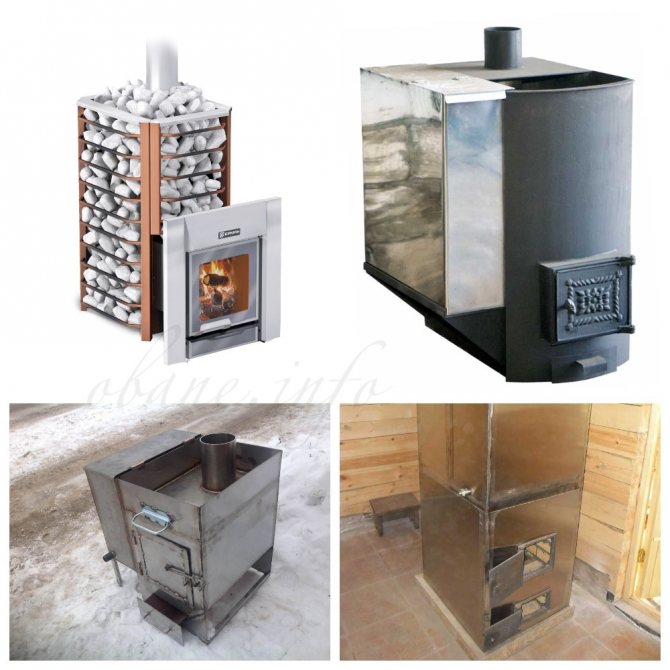

It is also worth noting the fact that the combustion temperature of high-quality dry birch firewood is about 760 degrees Celsius.
Important! The scale formation temperature of most structural steels is in the range of 380 - 440 degrees Celsius.
The mass fraction of chromium in the alloy is directly proportional to the scale temperature.
Materials used
The sauna heater or stove is made of the following materials:
- simple cast iron;
- steel billets;
- brick (hearth or red).
The service life of the selected structure depends on the quality of the raw material. The most durable are modern stoves made on the basis of chrome steel. Steel units guarantee a good heat, excluding the burning of oxygen in the steam room. The best examples of products are produced by Finnish and Harvia.
Bath equipment with a cast iron firebox is not easy to find, although the quality of the source material is considered good. Among the factory samples, the "Sudarushka M" from the domestic one deserves attention.
Brick stoves are perceived as a tribute to tradition and are built on the condition of reliable masonry. Brick stoves have their disadvantages, including many nuances:
- the complexity of the construction due to the lack of professional stove-makers;
- long heating (heating period);
- the need to equip a "powerful" foundation.
All this leads to an increase in the cost of making a brick stove for a bath with your own hands.
Sauna stoves
Many years ago, different peoples had differences between the baths. So, several centuries ago, the most common bath in Russia was stone or clay... Brick at that time was very expensive. It was made by hand, so only rich people could buy it. Over time, everything developed, the price of the material began to change, more people could already afford it.
According to the foundations, in the Russian steam room there must be a brick stove, which replaced the centuries-old stone one. The stove is an integral part of the bath, its heart, and its choice must be treated very responsibly. The brick oven in the bath is considered a classic for all its lovers.
There are a number of different kinds of additions and fireboxes of brick ovens:
- In a black way - the non-existence of the chimney, but the aroma and steam are more than enough, the disadvantage is that you had to wait a long time for the fuel to burn out.
- Over gray - there is a chimney, the steam room is warm, but it takes a lot of time to warm up.
- In white - there are no traces of soot, it stays warm for a long time, it can take up to 12 hours to warm up, it's all about the addition.
- With stove - the most successful option, the structure includes a tank, bath stones. The tank is lined with a brick wall on three sides, the high temperature of the water is better maintained.
Since ancient times, people have poured water on hot stones to wash and cleanse their bodies and breathe hot air with pleasure.Later, they began to fold the stoves, they were heated in black. They poured water onto the stones with a ladle so that hot steam would appear in the steam room. Currently, the structures are equipped with a chimney. However, some adherents of the Russian steam room to this day are steaming in black.
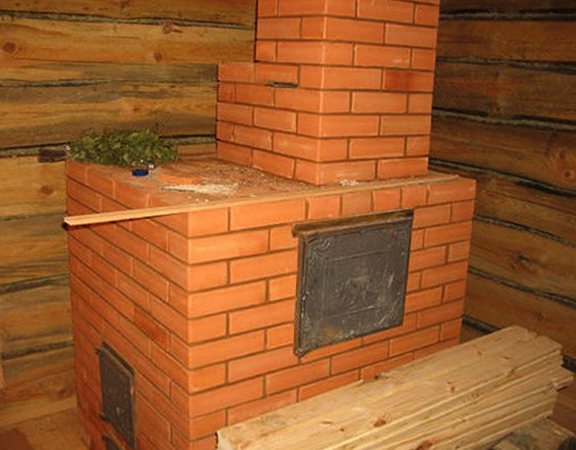

Self-production
Steel furnace structure
To make an iron stove in a bath with your own hands, you will need to prepare sheet steel of the maximum possible thickness. With limited costs, it is enough to choose steel sheets with a standard size of about 1.5-2.0 mm. After that, you need to do the following:
- Prepare a sketch of the furnace, where all the details and their characteristic dimensions are indicated.
- Calculate the number of structural elements and their total area.
- Determine the need for iron.
- Transfer the dimensions from the drawing to the metal, and then cut all the blanks.
When cutting with a grinder, you must strictly maintain angles of 90 degrees, and also make sure that the opposite sidewalls are the same in size. After that, a flat area is selected, on which the furnace body is assembled from the blanks. This will require:
Place two workpieces at an angle on the edges and make several tacks for welding. First, you need to adjust the current on the welding unit so that the arc does not melt the metal - then the seam will turn out to be uniform and strong. You need to grab 2-3 millimeters; 4-5 tacks are enough for one corner. It is important to control the position of the corner workpieces, since
the finished seam, after cooling, will lead the sheets to the sides. After aligning their position, check with a 90 degree square. In the same way, a second pair of workpieces for the sidewalls are tacked for spot welding. Two carbon body halves are attached and welded to maintain 90 degree joints.
The result is a steel box for the heater, to which it remains to weld the bottom and lid.
Popular models
Speaking about the best electric sauna stoves, it is worthwhile to understand that they are divided into two main groups. One is designed for 220 V, and the other for 380 V. Sawo SCANDIA SCA-60NB-Z can be considered a striking representative of the first type. The cost of this product is quite sparing. They put up to 20-22 kg of stones inside, so filling the room with steam is not difficult.
Also worth noting:
- convenience and simplicity of remote control;
- very high reliability;
- suitability for steam rooms with a volume of 5-8 cubic meters. m;
- linear dimensions 0.515x0.29x0.45 m;
- corrosion protection;
- redundant control loop directly on the body.
Harvia Cilindro PC70E is a great alternative. This Finnish development is high-tech and economical at the same time. The designers carefully selected the materials. A special container can hold up to 90 kg of stones. Outside, fire-resistant paint is applied, which is characterized by increased durability.
Technical properties:
- power 6800 W;
- dimensions 0.32x0.32x0.93 m;
- the volume of heated saunas is from 6 to 10 cubic meters. m;
- thermal regulators are located very low (which is not always convenient).
When choosing a sauna stove for 380 V networks, it is appropriate to pay attention to Sawo ARIES ARI3-60NB-CNR-P. This design will save free space in the steam room.
The tower-like housing ensures uniform distribution of heated air throughout the room. Watering the cobblestones located above or below with water allows, respectively, to provide an intensive supply of steam or light evaporation.
08f4aec813058e11f731dbe5966db48b.jpe
A built-in control panel is provided. The power of the device reaches 6 kW, which is quite enough for rooms with a size of 5-8 cubic meters. m. The size of the structure is 0.335x0.335x1 m.
Harvia Forte AF9 is also a good choice. This oven not only has an ergonomic design, but also looks very elegant. It can be used to heat a sauna up to 15 m2. Heating element power reaches 9 kW
Therefore, it is important to take care of powerful large-section wiring.
Harvia Club Combi K15GS is designed for saunas of 14-24 m2. The device has all the capabilities to work in 380 V networks
Important: the control system and fireplace will have to be purchased additionally. Developers strictly comply with the requirements of European standards in the field of safety and reliability
The absence of many functions compensates for the lightness (30 kg) and comparative compactness of the oven.
It makes sense for true lovers of open flame to choose "Termofor Vitruvia". The large viewing window allows you to simulate a large fireplace. The recommended area of the premises is 8-18 sq. m. Inside the firebox, you can put logs up to 0.5 m long.
